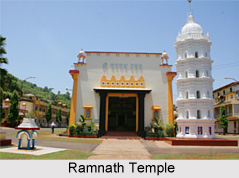 Ramnath Temple situated at Bandode near Ponda is known to have been constructed in around 1566 AD. The temple is dedicated to Lord Ramnath, a form of Lord Shiva worshipped by the Lord Rama. The temple is located 22 km from the state capital Panaji, Goa. It is just few minutes away from Farmagudi, off the main road to Ponda. The Ramnath Temple is the 2nd temple located in the small village of Bandode. The idol of Lord Ramnath was initially located at a settlement called Lotli present-day Loutolim. This was built by Gaud Saraswat Brahmins who had migrated from Rameshwar on the southern shores of India. Thus the temple belongs to the Saraswat Brahmins.
Ramnath Temple situated at Bandode near Ponda is known to have been constructed in around 1566 AD. The temple is dedicated to Lord Ramnath, a form of Lord Shiva worshipped by the Lord Rama. The temple is located 22 km from the state capital Panaji, Goa. It is just few minutes away from Farmagudi, off the main road to Ponda. The Ramnath Temple is the 2nd temple located in the small village of Bandode. The idol of Lord Ramnath was initially located at a settlement called Lotli present-day Loutolim. This was built by Gaud Saraswat Brahmins who had migrated from Rameshwar on the southern shores of India. Thus the temple belongs to the Saraswat Brahmins.
History of Ramnath Temple
When Goa was under the Portuguese rule many temples were demolished. During this time the idol of Lord Ramnath, along with other deities in Goa, was relocated from the original temple. It was placed in its present day abode of Bandivade. Bandivade was under the control of Bijapur at the time. In May 2011, the Ramnath temple completed 450 years at its present location.
Legend of Ramnath Temple
According to a legend the name of Lord Ramnath originated from the place Rameshwar. It is said that when Lord Rama came back from Lanka along with Sita, after killing Ravana, he was filled with remorse and repentance. So he decided to pray to Lord Shiva in order to absolve him of killing a Brahmin. Hence in order to get redemption for his actions he installed a Shivalingam (symbol of Lord Shiva), on the shores and Rama prayed to it. It was thus known as "Rameshwar" or "Ramnath".
Structure of Ramnath Temple
Shri Ramnath Deity was originally installed 3000 years B.C by Rama at Rameshwar. Since Ramnath is the chief deity, the temple came to be known as "Ramnath". Ramnath Temple incorporates the system of "Panchayasthan", therefore the temple houses 5 main deities namely - Shri Ramnath (chief deity), Shri Shanteri, Shri Kamakshi, Shri Laxmi Narayan, Shri Ganapati, Shri Betal and Shri Kalbhairav.
A striking feature of the temple is it does not have pillars in its "Sabhamandapa" (grand hall) of the temple. It has a special gallery for the ladies. Like the Mahalsa Temple this temple also has a 5-storied "Deepstambha" (lamp tower) in its courtyard. Images of Hindu saints are carved on its base. The door to the inner sanctum has some remarkable incidents carved on it in silver metal. It has scenes depicting devotees offering worship to a linga while the other shows Lord Vishnu with his consort Lakshmi sitting on his couch of a coiled snake.
Festivals at Ramnath Temple
The "Jatra" or the annual festival of the Ramnath Temple is celebrated with solemnity and merriment by the devotees with the traditional "Palakhi" (palanquin) moving around the temple carrying the idol of the deity.











